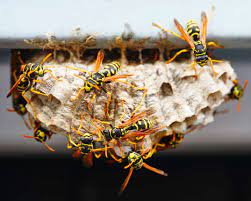Understanding Wasp Extermination : Nature’s Stinging Insects

Wasps, often perceived as aggressive and dangerous, are a common concern for many homeowners. Understanding their behavior and environment is crucial in dealing with a wasp infestation effectively. Unlike bees, wasps are predatory insects and can be more aggressive, especially when they feel their nest is threatened. Differentiating between wasp species, such as yellow jackets, hornets, and paper wasps, is essential as each requires a unique approach for safe removal. Wasp extermination involves safely removing or eliminating wasp nests to reduce the risk of stings and ensure a secure environment around homes or businesses. This process requires careful planning, the right tools, and a knowledge of safety precautions to effectively and safely address the problem.
Identifying Wasp Nests: Where to Look and What to Look For
Identifying wasp nests is a crucial step in managing a wasp problem effectively. These nests are often located in secluded and protected areas around homes and gardens. Common nesting sites include under eaves, inside attics, beneath decks, in dense bushes, and on tree branches. The nests themselves are typically made from a paper-like material, which the wasps create by chewing wood fibers mixed with their saliva. They can vary greatly in size, from small nests resembling a golf ball to larger ones that can grow to the size of a basketball or bigger as the colony expands.
When looking for wasp nests, it’s important to observe for wasp activity without getting too close. A steady stream of wasps flying to and from a particular spot often indicates the presence of a nest. The nests of different wasp species can vary in appearance. For example, paper wasps build open and umbrella-shaped nests, while hornets and yellow jackets often construct larger, enclosed nests. Identifying the type of wasp and nest is essential for choosing the right extermination method. It’s always advisable to approach this task with caution, as disturbing a nest can provoke an aggressive response from the resident wasps.
Preparing for Extermination: Safety Measures and Tools
- Protective Clothing: Ensure you’re wearing long-sleeved shirts, pants, and gloves to minimize the risk of stings. Cover as much skin as possible.
- Head and Face Protection: Use a hat or a bee veil to protect your face and neck, crucial areas that are particularly vulnerable to wasp stings.
- Footwear Safety: Wear closed-toe shoes or boots to prevent wasps from stinging your feet, especially if you’re dealing with ground nests.
- Optimal Timing: Plan to address the nest early in the morning or late in the evening. Wasps are less active and less aggressive during these times, reducing the risk of being attacked.
- Insecticide Choice: Choose the right insecticide for the job. Aerosol wasp sprays are effective for immediate contact, while dust formulations work well for treating the interior of nests.
- Insecticide Safety: Always read and follow the instructions on the insecticide label. Use products specifically designed for wasps to ensure effectiveness and safety.
- Escape Plan: Before starting the extermination, plan your escape route. Know where you will go if the wasps become agitated and start to swarm.
- Stay Aware of Surroundings: During wasp extermination, it’s crucial to be mindful of your surroundings, particularly avoiding tripping hazards, to maintain a clear and unobstructed retreat path for quick evacuation if necessary. This awareness is essential for ensuring safety throughout the extermination process.
Post-Extermination: Prevention and Maintenance
Seal Entry Points: Inspect your home for cracks and crevices, sealing any potential entry points to prevent wasps from entering and building new nests.
Regular Inspections: Periodically check common nesting areas like eaves, attics, and garages for early signs of new wasp nests.
Remove Food Sources: Keep outdoor eating areas clean. Cover food during picnics and promptly clean up any food spills to avoid attracting wasps.
Proper Garbage Disposal: Ensure garbage cans have tightly fitting lids and are emptied regularly. Wasps are attracted to food waste, especially proteins and sweets.
Trim Vegetation: Keep bushes and trees trimmed back from your house to reduce shaded areas where wasps like to build nests.
Avoid Floral Scents: Minimize the use of strong perfumes or scents when outdoors, as these can attract wasps.
Water Sources: Eliminate standing water in your yard, as it can serve as a water source for wasps.
Use Decoys: Install wasp decoys in areas where you want to deter wasps from building new nests. Wasps are territorial and usually won’t build near another nest.
Conclusion
Effective wasp control requires a combination of understanding, preparation, and action. While DIY methods can be effective for smaller infestations, professional help is advisable for larger or more dangerous situations. Remember, wasps play a role in the ecosystem, and our goal should be to manage them in a way that respects their place in nature while protecting our homes and families. By following these guidelines, you can achieve a safe and wasp-free environment.








